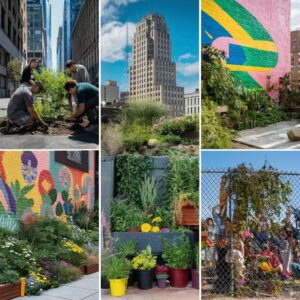In the face of growing urbanization, a quiet yet powerful movement is transforming cityscapes worldwide—guerrilla gardening. This grassroots initiative, driven by individuals passionate about reclaiming neglected urban areas, is making a significant impact on our environment and communities. But what exactly is guerrilla gardening, and why is it gaining so much momentum? In this article, we’ll explore the ins and outs of this radical approach to gardening, delving into its history, methods, and the profound benefits it offers to urban environments. Whether you’re a seasoned gardener or just curious about this movement, there’s something here for everyone.
What is Guerrilla Gardening?
Guerrilla gardening is an act of cultivating plants on land that gardeners do not have legal rights to use. This often involves abandoned plots, neglected public spaces, or even areas of land that are underutilized. The purpose behind this movement is to reclaim these spaces, turning them into green, vibrant areas that benefit the community and environment.

The Origins of Guerrilla Gardening
The roots of guerrilla gardening can be traced back to the 1970s in New York City, where activists began transforming vacant lots into community gardens. The movement was fueled by a desire to improve the quality of life in neglected urban areas, providing access to green spaces, fresh produce, and a sense of community. Over the years, guerrilla gardening has spread across the globe, with individuals and groups taking it upon themselves to beautify their cities.
How Guerrilla Gardening Works
Guerrilla gardening typically starts with a small group of people who identify a neglected space in their community. They gather the necessary tools and materials, often working under the cover of darkness to avoid detection by authorities. The goal is to plant a variety of flora, from flowers to vegetables, and to maintain the area so that it flourishes despite its unofficial status.
Essential Tools for Guerrilla Gardening
- Seed Bombs: These are small balls made of compost, clay, and seeds. They can be thrown onto hard-to-reach areas, making them a popular tool among guerrilla gardeners.
- Hand Trowels: Essential for planting seeds and small plants.
- Watering Cans: For keeping newly planted areas hydrated.
- Pruners: To trim overgrown plants and maintain the garden’s appearance.

Benefits of Guerrilla Gardening
Guerrilla gardening offers a host of benefits, both for individuals and communities. Here’s a closer look:
- Environmental Impact: By greening neglected urban areas, guerrilla gardening helps reduce air pollution, combat urban heat islands, and promote biodiversity.
- Community Building: These gardens often become a focal point for local communities, bringing people together and fostering a sense of ownership and pride in their neighborhoods.
- Food Security: In some cases, guerrilla gardens are used to grow fruits and vegetables, providing fresh produce in areas that might otherwise be food deserts.
- Aesthetic Improvement: Transforming barren lots into lush, green spaces enhances the beauty of urban areas, making them more attractive and livable.

Challenges and Risks Involved
While guerrilla gardening is a noble cause, it’s not without its challenges and risks. Since these gardens are often planted on land without permission, they can be destroyed by property owners or local authorities. Additionally, maintaining a garden in a public space can be difficult, especially if there’s no consistent source of water or protection from vandalism.
Legal Concerns
One of the biggest challenges for guerrilla gardeners is the legality of their actions. Planting on land without permission is technically illegal, and gardeners risk fines, prosecution, or the destruction of their work. However, many guerrilla gardeners see this as a form of civil disobedience, necessary to bring about positive change in their communities.
Successful Guerrilla Gardening Projects Around the World
Despite the risks, there have been numerous successful guerrilla gardening projects that have not only survived but thrived.
- London, England: Richard Reynolds, a prominent figure in the guerrilla gardening movement, has led numerous successful projects throughout London, transforming neglected urban spaces into thriving gardens.
- Los Angeles, USA: The LA Guerrilla Gardening movement has successfully cultivated several urban spaces, turning them into community gardens that produce fresh food for local residents.
- Berlin, Germany: The city is home to several guerrilla gardens, many of which are now recognized and supported by local authorities as valuable community resources.
How to Get Started with Guerrilla Gardening
If you’re inspired to start your own guerrilla garden, here’s a step-by-step guide:
- Identify a Site: Look for neglected or underused areas in your community that could benefit from some greenery.
- Plan Your Garden: Decide what you want to plant, taking into consideration the local climate and soil conditions.
- Gather Supplies: You’ll need seeds, soil, tools, and perhaps a few friends to help you with the planting.
- Planting: Choose a time when the area is less likely to be disturbed, often early in the morning or late at night.
- Maintenance: Regularly check on your garden, watering it and removing any weeds or trash.
Sustainable Practices in Guerrilla Gardening
To ensure your guerrilla garden is sustainable, consider the following practices:
- Native Plants: Choose plants that are native to your area, as they are more likely to thrive with minimal care.
- Water Conservation: Use methods like mulching and drip irrigation to reduce water usage.
- Composting: Create your own compost to enrich the soil naturally.

The Future of Guerrilla Gardening
As urban areas continue to grow, the need for green spaces becomes more critical. Guerrilla gardening is likely to play an increasingly important role in shaping the future of our cities. With more people becoming aware of the benefits of this movement, we can expect to see a rise in community-led gardening projects that transform urban environments into healthier, more sustainable spaces.
Conclusion
Guerrilla gardening is more than just an act of rebellion; it’s a way to reclaim our cities, foster community spirit, and contribute to environmental sustainability. By transforming neglected spaces into green havens, guerrilla gardeners are making a real difference in the world, one plant at a time. Whether you’re looking to join the movement or simply support it, guerrilla gardening is a powerful example of how small actions can lead to big changes.
FAQs about Guerrilla Gardening
Q1: Is guerrilla gardening illegal? A1: Technically, yes. Guerrilla gardening often involves planting on land without the owner’s permission, which can lead to legal consequences.
Q2: What types of plants are best for guerrilla gardening? A2: Native plants and hardy species that require minimal care are ideal, as they are more likely to thrive in neglected urban areas.
Q3: How do you water a guerrilla garden? A3: Guerrilla gardeners often bring water with them or rely on rainwater. Using mulch can help retain moisture in the soil.
Q4: Can guerrilla gardening help with food security? A4: Yes, many guerrilla gardens focus on growing vegetables and fruits, which can provide fresh produce for local communities.
Q5: What should I do if my guerrilla garden is destroyed? A5: It’s disheartening, but persistence is key. Find another site and start again, perhaps with better planning or community support.
Q6: How can I support guerrilla gardening without planting? A6: You can support the movement by donating supplies, spreading awareness, or even lobbying for more green spaces in your community.